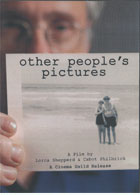
Other People’s Pictures 2004
Distributed by Cinema Guild, 115 West 30th Street, Suite 800, New York, NY 10001; 212-685-6242
Produced by Lorca Shepperd and Cabot Philbrick
Directed by Lorca Shepperd and Cabot Philbrick
DVD, color, 53 min.
Adult
Popular Culture, Psychology
Date Entered: 08/14/2007
Reviewed by Dan DiLandro, E.H. Butler Library, State University of New York College at BuffaloOther People’s Pictures documents people who, one might think oddly, collect discarded snapshots. Told in typical documentary fashion, the film follows various collectors and provides insights into their collecting, revealing individual—and certainly deeper collective—motivations for assuming “other people’s pictures.”
While the subject matter might seem very “slight,” one collector underscores the weight of this film early by asking why people collect objects: “Why [do some people] collect spoons? Plates? Anything?” This query both presents the immediate theme of the film while providing it with a springboard for a deeper exploration into the psychology of collecting. That is, on the one hand, the film evokes a whimsical air, but it also explores more personal motivations. Nothing is presented in a “throw away” fashion, but every topic will necessarily lead to deeper wonder or understanding about people in general. For example, even seemingly “non-issues” such as the argument among vendors regarding breaking up found or auctioned photo albums demands viewers to consider something of the continuity of history (what professional archivists refer to as “respect du fonds”). The argument speaks to the individual value of a discrete image versus its place within a series of like material, art versus integrity.
Indeed, this is a somewhat heady intellectual demand for a film that might seem quite ephemeral!
In any case, though, the vendors and collectors are presented without pretension; only their stories ask deeper questions of the audience. One frequent collector, for instance, professionally works with the developmentally disabled, and her interest is in snapshots detailing the same. Of 40,000 images, she says, she’s discovered only four shots of a child identifiably living with Down’s Syndrome. “Why,” she asks; and answers the question by pointing out that these children were so often removed to asylums, evoking a serious social concern, indeed.
Two other collectors assume images of “women with attitude” and homosexual or -erotic shots of men, respectively. (The latter and some other images, notably, contain full-frontal nudity of both sexes, and are thus inappropriate for younger audiences.) Both conclude that they are saving a social history, as it were; and audiences might be surprised to find that, upon consideration, there is at least a certain amount of truth to that assertion.
On a more personal note, one collector describes his Japanese, Hawaiian, and American heritage, showing his collection of subsets of snapshots of Hawaii. He tells that this provides him with a “connection with people I grew up with.” And this idea will provide interested audiences with a platform for considering personal identity and how we consider ourselves to “fit into” overall society.
Another collector describes how his mother, after entering a religious cult, certainly destroyed all of his childhood albums. Collecting photographs that “nobody else wants,” he says, somehow parallels his own childhood, demanding of the viewer to consider sense of self-identity.
And again another collector of “other people’s pictures” focuses on his definition of “the banality of evil”: His father was the only member of his Polish family who escaped the Holocaust, and he collects pictures of men in Nazi uniforms at weddings, at home -- in somewhat “terrifyingly“ normal domestic scenes. Displayed in his home across the hall from photographs of his own ancestors, this collector demands important questions regarding the appearance of evil. “You don’t see the evil on the surface,” he says; and implicitly demands the viewer to make sense of a posed image of a wife and husband, the latter attired in a Nazi jacket off of which someone, at some time, had scratched out the SS insignia.
Interspersed with the stories are sometimes laugh-out-loud interstitials that say “Other people collect...” such things as Halloween images, “photographers’ shadow” mistakes, the surreal (“Why did they take this?”), and so on. Particularly amusing are the mutilated snapshots, in which eyes, a face, an entire figure have been scratched or cut out. At every point Other People’s Pictures asks the viewer to wonder why without condemning anyone at all.
Admittedly, I feel that I must express my bias: I often employ “unusual” photographs with students, asking them to “decode” the information contained within them in order to describe the scene, the time, etc. That said, I am personally and professional thrilled with the Thematic Apperception Test-like quality of collectors intrigued by “the unfinished story.” Regardless, while Other People’s Pictures is demonstrably something of a niche product, it is highly recommended for library, curricula, and special collections that emphasize popular culture and history as well as group psychology.
Awards: